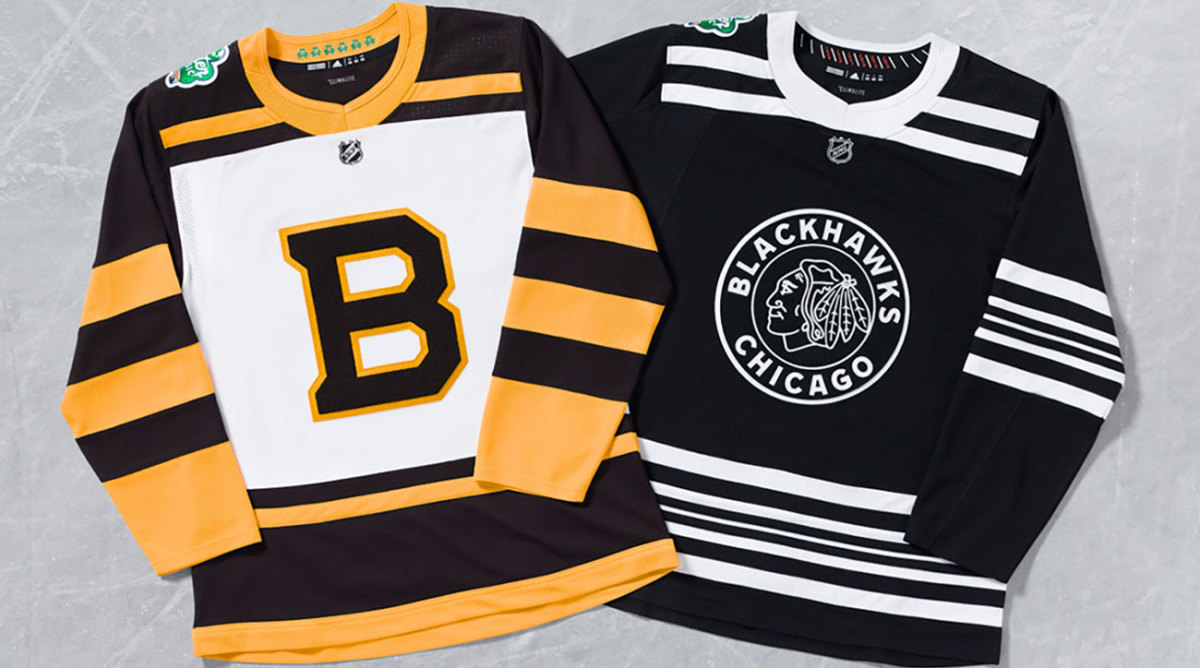How the 2019 Winter Classic Jerseys Came Together

This story appears in the Dec. 31, 2018, issue of Sports Illustrated. For more great storytelling and in-depth analysis, subscribe to the magazine—and get up to 94% off the cover price. Click here for more.
Over nearly three decades as the NHL's executive vice president of marketing, Brian Jennings has amassed what he calls "a treasure trove of uniforms" in his midtown Manhattan office. They are organized and omnipresent, neatly stacked on shelves or crisply folded on the heating unit. Perhaps his favorite batch lives atop the mini-fridge. It is there that Jennings keeps every Winter Classic team sweater since the annual event's inception in 2008.
When the Blackhawks host the Bruins at Notre Dame Stadium on Jan. 1, another pair will join the pile. These outdoor games already drench hockey fans in nostalgia—see: countless wistful articles about starry-eyed children skating on frozen ponds—but the 2019 installment reaches way, way back. With Boston's uniform largely influenced by its 1932–36 squads and Chicago's modeled after the '33–34 Stanley Cup champions, this Winter Classic will channel the Depression–era NHL at a stadium that opened around that same time, featuring a rematch of rival … sweaters.
As Adidas Hockey design director Matty Merrill says, "Thinking about it gives me goose bumps."
PREWITT: Jack Eichel Wants It All as the Sabres Rediscover Relevancy
Like most creative projects, the process of designing the throwback sweaters begins with a pitch meeting. "We try to find a unique thread—no pun intended—to figure out the angle we're going to take, the story behind the inspiration for the jersey," Jennings says. In this case, outfitting two Winter Classic veterans—the Bruins are playing their third Classic, the Blackhawks their fourth—meant reaching back to the franchises' first Stanley Cups: 1929 and '34, respectively.
At the suggestion of Bruins president Cam Neely, Boston's kit was modified to include the varsity-style “B” from the mid-1930s, rather than the bear logo worn by those first champions. The Blackhawks uniforms, however, went largely unchanged from their black-and-white '33–34 version. "This will be the first time they haven't had red in their kit since that 1934 Stanley Cup championship," Merrill says. "There is always something new to discover."
According to Jennings, new uniforms typically take 18 months to roll out; the Winter Classic kits are finished in just eight. Two- and three-dimensional computer renderings are generated. Conference calls are held to discuss number size and fonts. Prototypes are manufactured at a factory in Quebec. Around mid-November, the finished products were shipped to teams for final adjustments and customizations.
This particular project holds a special place for Jennings. He grew up as a Bruins fan in Bedford, N.Y., pretending to be Bobby Orr while playing hockey on a neighbor's pond. (See?) Years later, Jennings would beam as his beloved B's entered at Fenway Park for the 2010 Winter Classic, then again in '16 at Gillette Stadium. That is his favorite part, when the teams strut out of the tunnel for the first time, retro jerseys gleaming in the daylight. “We’re not looking to create a progressive uniform,” Jennings says. “This is a look back into all the things that make hockey a great outdoor game and evoke that type of emotion.”
































